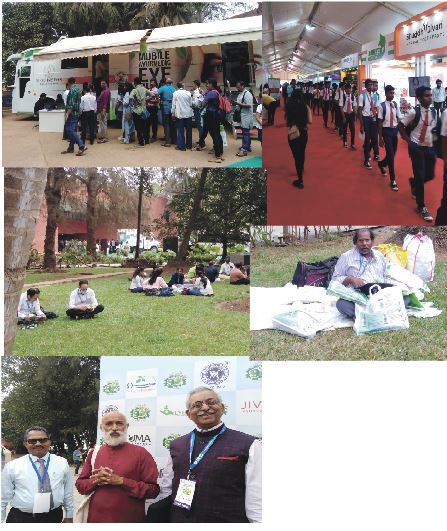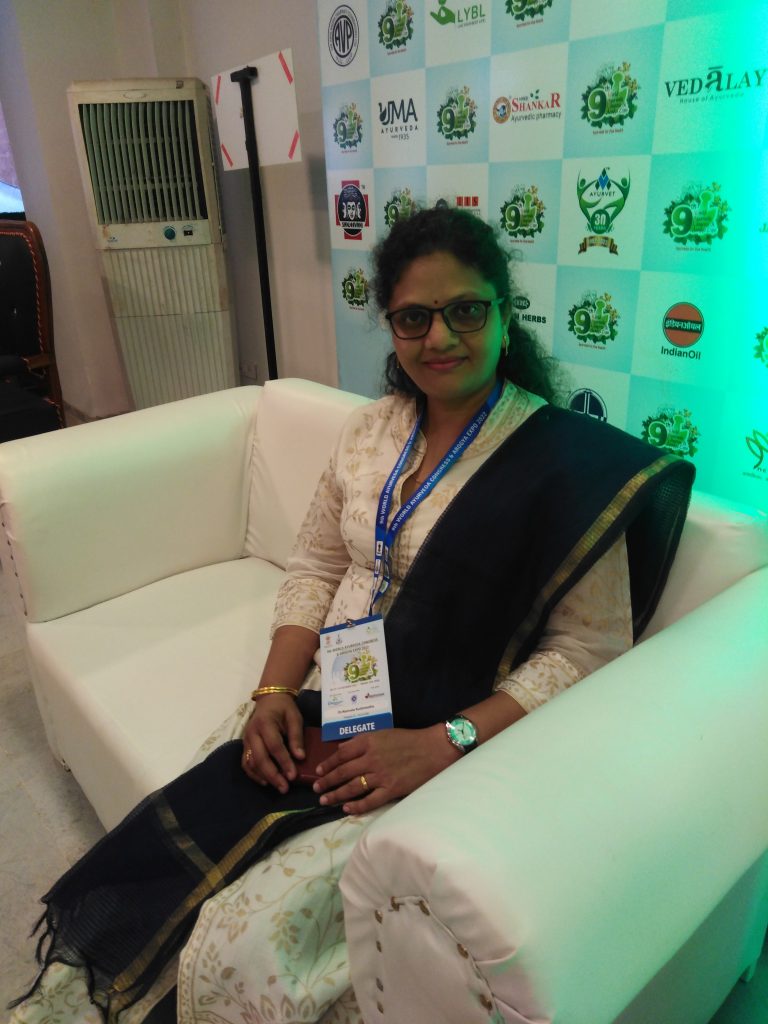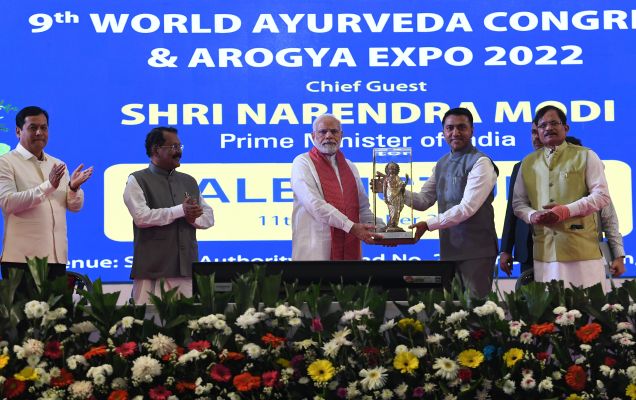AT 9th WORLD AYURVEDA CONGRESS VALEDICTORY FUNCTION ON DECEMBER 11, 2022…Chief Minister Dr Pramod Sawant offers Prime Minister Narendra Modi a memento. Other dignitaries are Governor of Goa PS Sreedharan Pillai, Ayush Minister Sarbananda Sonowal, Minister of Tourism Shripad Naik. The 4-day AYUSH expo offered eye-opening insights into how Ayurveda and yoga have travelled a long way in the last nine years since the BJP came to power. A happy PM observed that the Ayush industry, worth about Rs20,000 crore eight years ago, is today worth Rs1.5 lakh crore, a seven-fold growth!
By Pankajbala R Patel
CAN Ayurveda replace mainstream Allopathy in time to come or any time soon? You’d think so by the amount of push, hosting, subsidizing the AYUSH ministry has been doing since 2014 – on public account of course! I have it on good account that while Prime Minister Narendra Modi was in smart town Panaji for the 9th World Ayurveda Congress & International Arogya Expo on December 11, 2022, there was a room booked for him and on stand-by at the nearby Manipal hospital in case he got into any kind of a health emergency!
See, in an emergency nobody is going to take you to an Ayurveda or Homeopathy or Unani or Siddha or any other traditional medical facility. In Goa it would be straight to the GMC or any other best private hospital nearby which swears by the gold standards of Allopathy. Nevertheless, I’m not knocking Ayurveda. I will say it is the best traditional preventive healthcare and I have equal respect for the other systems in other countries. The alternative medical systems have their integrity in healing in more wholistic or holistic ways and are sciences in a class of their own. The developed world is now accommodating integrated healthcare systems and that is what India must aim to do as soon as possible. Keep an open mind!
GOING OUT OF REACH
BUT as far as Ayurveda is concerned I wish somebody would impress upon the PM that with all the public funds driving Ayurveda and the other “pathies” along with revamping old and inaugurating new institutions, colleges, hospitals – and more and more companies cleaning up their act vis-à-vis research, better presentation of their pharmacopeia (sorry, much of it is going into plastic packaging, not environment-friendly at all), and more and more students with degrees and several supplementary diplomas…yes, the old-fashioned classical and traditional Ayurveda is going out of the reach of the common man.
Today Ayurveda booming business and like any other business hopes to spin fortunes by hook or by crook. Either through exports or with more and more Ayurveda groups investing in these good, bad or ugly Ayurveda resorts/retreats (no longer ashrams) offering wellness packages costing half-a-million rupees plus, plus for a week’s stay along with Ayurveda or so called Ayurveda treatments for body beautiful no matter to what its state of degeneration. Ayurveda’s de-tox panchakarma regime package is very popular with the best wellness centers offering it.
Even the undoubtedly engaging Baba Ramdev now has his Patanjali Wellness Yoga, Ayurveda & Naturopathy wellness center somewhere out in Pune wooing patients from abroad or the wealthy of India! This, apart from his ashram establishments in Haridwar and branches elsewhere, social or commercial in manners. While taking in this year exhaustive AYUSH expo at the Kala Academy and adjoining grounds one couldn’t help thinking if Ayuveda is now heavily export-oriented and only for the privileged wealthy few?
Hey, you can’t get an Ayurveda massage for Rs100 today, at one time one could get it for less in an ashram of old in India (eg Uruli Kanchan, or it was just part of a daily package for a week or a month and no extra charges).Today, Ayurveda massages cost Rs2,000 to Rs5,000 plus and who’s indulging in them? Go find out! Wellness retreats charge handsomely for accommodation but treatment charges are added on billing, plus whatever useful products you may prescribed by the Ayurvaidyacharya in residence or what you find would be useful like say a jalneti pot, or sandalwood powder or even rosewater.

At the expo one noticed only the Ayurveda-inspired more economical products are for the aam aadmi – the hard-boiled herbal candies, syrups, jams, jellos, biscuits, cookies, lemon and aonla murabba and pickle, various interesting and not so interesting condiments sweet or bitter-sweet. All this came home to me clearly at the 9th World Ayurveda Congress and Arogya Expo 2022. In the last seven years Ayurveda has become a mega business and there is no stopping it, it’s on a roll mostly good, but occasionally bad and outright ugly.
I am an Ayurveda believer having seen its efficacy work with health problems I have had. At various chemist’s shops one may see hordes of Russian tourists on holiday in Goa investing in king and queen of Ayurveda herbal medicines “ashwagandha” (Withania somnifera) and “shatavari” (Asparagus racemosus), respectively – buying home packets of herbal powders, oils, tablets, capsules, churan and now there are the clear distilled “arq” of spices and herba.There are all kinds of herbal combinations so that we may eat better, digest better, sleep better, feel better and happier about life in general and life in specifics! There’s a European Academy of Ayurveda in Germany. There are thousands of foreign students studying Ayurveda in prestigious colleges in Kerala, Tamilnadu, Benaras, Pune, Gandhinagar and elsewhere in India.
RESPECT ALL HEALTHCARE
SO I am not knocking Ayurveda or any other country’s ancient traditional healthcare systems – they are very efficacious if followed with discipline, as far as preventive healthcare is concerned and if the medicines for prescription are formulated along the lines detailed in the classical Sanskrit literature texts (for example, Sasruta Samhita, volumes 1, 2, 3 and related texts) which have come down from generation to generation in the last 5,000 years.
Quite simply in today’s times there’s such a mindboggling mix of the honest and dishonest that one must really do one’s homework before making up one’s mind about which Ayurveda pharmacy is bona fide and which not so bona fide but which takes short-cuts for reasons of convenience and commerce.
OTHERS SAYING IT TOO!
AND I am not the only one saying that Ayurveda is on a roller coaster ride giving itself both a good and bad name. There were quite a few worthies of Ayurveda at the expo who admitted that Ayurveda has slipped into being a disagreeable mega business in India and abroad…and much of it is not classical Ayurveda but new offshoots or avatar of various spurious combination.
A Dr S N Gupta of Nadiad in Gujarat in his talk at the expo agreed Ayurveda is being needlessly compromised with given all the promotion coming from the top, “The new batch of students coming out of college are not practising Ayurveda as it has been taught to them. When business enters Ayurveda is spoilt.” He is against the branding of Ayurveda, it is the branding of products which is giving authentic classical Ayurveda a bad name!
Agreeing with him is Ajay Karmayogi who spoke of running 33 gurukul establishments the country over (some sponsored by a trust abroad). He says Ayurveda medicines are not meant to be packaged and branded as they are now, “In the old days Ayurveda treatment was face to face and patients got the medicines in an envelope or clean piece of paper according to their needs and what ailed them….len den bilkul nahi thi. Ayurveda naivedanya this (like prasadam or offering to the gods).” Ayurveda was a social and not a commercial service as it is today. He describes today’s Ayurveda students as “kitaabi keede!” They study the texts without understanding anything!
HOW MUCH IS AYURVEDA WORTH?
WITH the four-day 9TH World Ayurveda Congress & International Arogya Expo in capital town Panaji under way it is time for Goa to decide whether it wants to get on to the gravy train of promoting Ayurveda the Kerala way or not! In Kerala Ayurveda is a way of life from down to top society and accessible to everybody at a reasonably aam aadmi-friendly price.
Or does Goa just want to reap the rewards of tourism vis-à-vis Ayurveda’s healing treatments represented by half-a-dozen massages of rejuvenation fame and fortune? Ayurveda medicines are cheaper to find than the various Ayurveda-based massages which from the one-time Rs500 and less are now anything from Rs2,500 to Rs5,000 in the wellness spas, and one may not even be sure if the masseur is a trained masseur or somebody picked up locally and given a few casual half-baked lessons!
In Ayurveda, massage is not just a cosmetic beauty treatment aiming to rectify bodily afflictions. It is much more. There is no doubt about the fact that Ayurveda in toto or in bits and pieces has become a fatted gravy train ever since Prime Minister Narendra Modi decided to go global with its promotion on an obsessive footing since 2014. It is not as if such things as yoga and the de-tox regime of panchakarma have not caught in the other countries, but in India it has been steadily been going out of reach of the common people or aam aadmi and into the hands of the rich and the beautiful who holiday in five-star resorts and wellness centers – in short, in the hands of khaas aadmi.
One may well say soon the Ayurveda industry will be competing with mainstream Allopathy healthcare in terms of spinning fortunes! Just how much is Ayurveda worth today? At the press conference held before the 9th World Ayurveda Congress got under way. Ayush Deputy Director-Export Council Ashutosh Shrivastava responding to a query said in 2018 Ayurveda exports totalled US$25,000 and in 2020 it was up to US$40,000 and India would like to do better in this direction of course. Sell India’s traditional healthcare and healing system to the developed rich countries of the world – in the US, Russia, Middle East, China, Japan.
At the Ayush expo’s inaugural ceremony at the SAG grounds Minister of Ayush Secretary Rajesh Kotecha said in the last eight years the traditional healing systems have grown significantly and it will be soon be a ten billion dollar business. Ayurveda is naturally the biggest ambassador of brand India in the world and consider the scenario when India’s Ayurveda colleges start churning out thousands of Ayurveda practitioners. Will Ayurveda replace Allopat
`Drink goat’s milk if you have ortho problems!”

